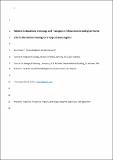Patterns in departure phenology and mass gain on African non-breeding territories prior to the Sahara crossing for a long-distance migrant
Date
10/2015Metadata
Show full item recordAbstract
Afro-Palaearctic migrants are declining to a greater degree than other European species, suggesting that processes occurring in Africa or on migration may be driving these trends. Constraints in food availability on the wintering grounds may contribute to the declines but little is known about when and where these resource constraints may occur. Sufficient resources are particularly important prior to spring migration, when migrants must cross the Sahara desert. We examined mass gain and departure phenology in a long-distance Palaearctic passerine migrant to determine the degree to which pre-migratory fattening occurs in their long-term non-breeding territories in the Guinea Savannah region of Africa. We monitored 75 Whinchats Saxicola rubetra for departure from their non-breeding territories in one spring, and analysed mass data of 377 Whinchats collected over three non-breeding seasons plus 141 migrating Whinchats caught in April over eight years, all within the same few square kilometres of anthropogenically-modified Guinea Savannah in central Nigeria. Whinchats left their winter territories throughout April, with males departing on average eight days earlier than females. However, there was no evidence that time of departure from territory was linked to age, body size or mass at capture. Whinchats departed their territories with a predicted mass of 16.8 ± 0.3 g, which is much less than the ~24 g required for the average Whinchat to cross the Sahara directly. Comparing departure dates with arrival dates in southern Europe shows a discrepancy of at least two weeks, suggesting that many Whinchats spend considerable time on pre-migratory fuelling outside of their territory prior to crossing the Sahara. Over-wintering birds gained mass slowly during February and March (0.03 gd-1 34 ), and non-territorial or migrating birds at a much higher rate in April (at least 0.23 gd-1 35 ), with up to 20% of migrating Whinchats in April potentially having sufficient fuel loads to cross the Sahara directly from central Nigeria. Our results suggest that most Whinchats leave their winter territories to fatten up locally or, possibly, by staging further north. Resource constraints are therefore likely to be particularly focussed in West Africa during mid-April and possibly at staging areas before the crossing of the Sahara desert.
Citation
Risely , A , Blackburn , E & Cresswell , W 2015 , ' Patterns in departure phenology and mass gain on African non-breeding territories prior to the Sahara crossing for a long-distance migrant ' , Ibis , vol. 157 , no. 4 , pp. 808-822 . https://doi.org/10.1111/ibi.12288
Publication
Ibis
Status
Peer reviewed
ISSN
0019-1019Type
Journal article
Description
This work was supported by the British Ornithologists’ Union, the Linnean Society, the A.P. Leventis Foundation and Chris Goodwin.Collections
Items in the St Andrews Research Repository are protected by copyright, with all rights reserved, unless otherwise indicated.

